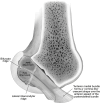Principles for optimizing anterior cruciate ligament reconstruction outcomes in elite athletes: a review of current techniques
- PMID: 38694814
- PMCID: PMC11061659
- DOI: 10.21037/aoj-22-40
Principles for optimizing anterior cruciate ligament reconstruction outcomes in elite athletes: a review of current techniques
Abstract
Anterior cruciate ligament (ACL) tears are one of the most common sport-related injuries and occur in greater than 3% of athletes in a four-year window of sports participation. Non-contact injuries are the most common mechanism for ACL injury in elite-level athletes, especially with increased valgus and external rotation of the knee when loading eccentrically in flexion. Because of the immense toll these injuries and their recovery take on athletes especially, optimal treatment has been a subject of great interest for some time. Many ACL reconstruction (ACLR) and repair techniques have been implemented and improved in the last two decades, leading to many surgical options for this type of injury. The surgical approach to high-level athletes in particular requires additional attention that may not be necessary in the general population. Important considerations for optimizing ACL treatment in high-level athletes include choosing repair vs. reconstruction, surgical techniques, choice of auto- or allograft, and associated concomitant procedures including other injuries or reinforcing techniques as well as attention to rehabilitation. Here, we discuss a range of surgical techniques from repair to reconstruction, and compare and contrast various reconstructive and reinforcing techniques as well as associated surgical pearls and pitfalls. Good outcomes for athletes suffering from ACL injury are attainable with proper treatment including the principles discussed herein.
Keywords: Anterior cruciate ligament (ACL); graft; reconstruction; repair.
2024 Annals of Joint. All rights reserved.
Conflict of interest statement
Conflicts of Interest: All authors have completed the ICMJE uniform disclosure form (available at https://aoj.amegroups.com/article/view/10.21037/aoj-22-40/coif). The series “Implications of Graft Choice in ACL Reconstruction” was commissioned by the editorial office without any funding or sponsorship. J.K.M. declares that he receives presenter honorarium for the Smith & Nephew MACKIS meeting and support for meeting travel from OSET Meeting, in Boston, MA (9/23-25/2023). N.I.K. declares that he receives $1,500 from Vericel for a Fellows teaching course. R.F.L. declares that he receives research grants from AOSSM, AANA, Ossur, Smith and Nephew, royalties or licenses from Ossur, Smith and Nephew, and Elsevier, and consulting fees from Ossur and Smith and Nephew. He holds patents planned, issued or pending in Ossur, and Smith and Nephew and serves on editorial boards of AJSM, KSSTA, JEO, JKS, and OTSM. The authors have no other conflicts of interest to declare.
Figures






Similar articles
-
ACL reconstruction in the professional or elite athlete: state of the art.J ISAKOS. 2021 Jul;6(4):226-236. doi: 10.1136/jisakos-2020-000456. Epub 2021 Feb 16. J ISAKOS. 2021. PMID: 34272299 Review.
-
Report of the Clinical and Functional Primary Outcomes in Men of the ACL-SPORTS Trial: Similar Outcomes in Men Receiving Secondary Prevention With and Without Perturbation Training 1 and 2 Years After ACL Reconstruction.Clin Orthop Relat Res. 2017 Oct;475(10):2523-2534. doi: 10.1007/s11999-017-5280-2. Clin Orthop Relat Res. 2017. PMID: 28224443 Free PMC article. Clinical Trial.
-
Risk Factors for Anterior Cruciate Ligament Graft Failure in Professional Athletes: An Analysis of 342 Patients With a Mean Follow-up of 100 Months From the SANTI Study Group.Am J Sports Med. 2022 Oct;50(12):3218-3227. doi: 10.1177/03635465221119186. Am J Sports Med. 2022. PMID: 36177758
-
Anterior Cruciate Ligament Reconstruction in High School and College-Aged Athletes: Does Autograft Choice Influence Anterior Cruciate Ligament Revision Rates?Am J Sports Med. 2020 Feb;48(2):298-309. doi: 10.1177/0363546519892991. Epub 2020 Jan 9. Am J Sports Med. 2020. PMID: 31917613 Free PMC article.
-
Should Return to Sport be Delayed Until 2 Years After Anterior Cruciate Ligament Reconstruction? Biological and Functional Considerations.Sports Med. 2017 Feb;47(2):221-232. doi: 10.1007/s40279-016-0584-z. Sports Med. 2017. PMID: 27402457 Free PMC article. Review.
Cited by
-
Repeat Revision Anterior Cruciate Ligament Reconstruction Remains a Challenge for Orthopedic Surgeons.Arch Bone Jt Surg. 2025;13(2):114-118. doi: 10.22038/ABJS.2024.76809.3549. Arch Bone Jt Surg. 2025. PMID: 39980795 Free PMC article.
-
Anesthetic Considerations in Athletes: A Review.Cureus. 2025 Mar 23;17(3):e81040. doi: 10.7759/cureus.81040. eCollection 2025 Mar. Cureus. 2025. PMID: 40271321 Free PMC article. Review.
References
-
- Waldén M, Hägglund M, Magnusson H, et al. ACL injuries in men's professional football: a 15-year prospective study on time trends and return-to-play rates reveals only 65% of players still play at the top level 3 years after ACL rupture. Br J Sports Med 2016;50:744-50. 10.1136/bjsports-2015-095952 - DOI - PubMed
Publication types
LinkOut - more resources
Full Text Sources
